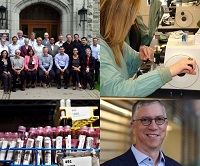Did you know that anything that comes out of a patient and gets sent to the lab gets sent to one of the Department of Pathology and Molecular Medicine’s laboratories? Newly-elected Department Head Dr. David Berman says the Pathology Department, “does research, education and a lot of clinical service. We also provide leadership to a number of laboratories across the province, including Perth, Smiths Falls, Napanee, and Brockville. We’re a major referral centre for patients between Peterborough and Ottawa.”
Department of Pathology and Molecular Medicine’s laboratories? Newly-elected Department Head Dr. David Berman says the Pathology Department, “does research, education and a lot of clinical service. We also provide leadership to a number of laboratories across the province, including Perth, Smiths Falls, Napanee, and Brockville. We’re a major referral centre for patients between Peterborough and Ottawa.”
Dr. Berman details how the Department has 28 SEAMO physicians, including seven clinician scientists (Dr. Berman and Drs. Neil Renwick, David Lillicrap, Tricia Cottrell, Michael Rauh, David Lebrun, and Jeannie Callum) and six clinical PhDs who run laboratories focused on things like genetics, microbiology and clinical chemistry. Dr. Berman acknowledges that the Department is extremely high-functioning. “My predecessors created a department where we all feel lucky to work here and we can do high-quality work. We’re completely sub-specialized, so if you have, let’s say, a gynecologic specimen that needs to be examined for cancer or for any disease, it will go to somebody who is specialized in diseases of the female reproductive tract,” he says. “Those pathologists have special experiences and expertise in those diseases and can give clinicians the most important information and the most accurate reads. That’s something you don’t see in even much larger hospitals across the province, and it adds quality and academic power to the whole centre.”
According to Dr. Berman, there are huge strides being made in the field of pathology. “There are a lot of developments around data science and digital pathology that are going to bring about a revolution where we replace some of our more difficult judgement calls with quantitative data,” he says. “For example, depending on whether a bladder cancer is low grade or high grade, the patient will be treated very differently. Currently, we have variables to look at, but no precise formulas or thresholds for how to apply those variables in cancer grading. With computerized analyses, we’re going to be able to measure all those features, create objective thresholds and align them to the clinical outcomes. Through this process, we can make pathology more reliable and practice it more like the next person practicing it and it will be much more fine-tuned.”
Dr. Berman says the same approaches can be used to mine new connections and improve medicine across the board. “We may be able to find new information about how to control bleeding or diabetes and certainly COVID-19,” he says. “During the pandemic, our microbiology laboratory has made it possible for Kingston to have an exemplary COVID-19 strategy. Our facility led by Drs. Prameet Sheth and Lewis Tomaltye is now a major centre for sophisticated sequencing to understand the variants that are coming along. I’m excited about using these and other data streams to improve patient care – to make Kingstonians healthier.”
Dr. Berman says most of the digital pathology work being done by the Department so far has been in the research realm, though they are poised to implement it clinically. “As part of that process we recruited Dr. Tricia Cottrell, a new clinician scientist from Johns Hopkins who is looking at the immune landscape of tumours using multispectral immunofluorescent imaging. We’re excited about the possibilities of using her profiling technologies to better pair patients with immunotherapies,” he says. “Immune pathology is an area that’s expanding. We have a number of initiatives in the molecular biology of leukemia and lymphoma that are coming along nicely, including basic research as well as new molecular testing that we’re bringing on in the clinical laboratories.” This could have major impacts on research, Dr. Berman says. “Dr. Harriet Feilotter who runs clinical genomics in the department also plays major roles on the provincial level, is bringing on new tests for cancer. There’s going to be a major expansion of those tests, which will provide a lot more molecular information on each patient. Right now, the benefits to patients are only hypothetical. It will be critical to research how that new testing will benefit patients.”
The importance of building a profile for Pathology is something Dr. Berman says his Department is well aware of. “Pathologists recognize the need to move out of the proverbial basement and meet patients and other physicians to better explain what we have to offer and to let them know we care about patient health. We’re here for the patients and the physicians. We like to be consulted and we want to partner with the other specialties and primary care providers to improve patient care.”
For more information on the Department, please visit their website.
